Improving Voltage Quality through Transformer Construction in Accra, Ghana

We analyze 337 million customer-level reliability and voltage measurements, collected from more than 1,000 utility customers over the span of six years, and survey data from over 2,000 households and firms in Accra, Ghana, to generate some of the first evidence on the large-scale economic costs of poor voltage quality.
At a Glance
Key Challenge
Many customers routinely experience voltage well below the 230V mandated by Ghana’s electricity regulatory agency. This problem is especially pronounced during peak demand hours of 6PM to 10PM, where many households and businesses routinely experience voltage more than 20% below nominal voltage.
Policy Insight
Households and businesses are willing to pay similar amounts for electricity connections with reduced outages and with improved voltage, indicating that electricity quality imposes similar costs on customers as electricity reliability.
Novel sources of spatially and temporally high-frequency data—such as satellite imagery, internet-of-things, and mobile phone records—have massively expanded the scope and precision for measuring economic variables. For example, within the electricity sector, data from utilities on customer billing and consumption has led to new insights on responses to electricity prices and behavioral patterns in energy use.
But research on the quality of electricity—an important problem in many low- and middle-income country contexts—has largely relied on coarse data from utilities or from customer self-reports. Our research collects and analyzes high-frequency customer-level data to provide insight into the nature and impacts of voltage quality, a little-understood yet core underpinning of modern energy access.
Electric appliances require voltage within a specific range to operate optimally and can be damaged by low or high voltage. Voltage problems can manifest in several distinct ways. Under-voltage spells—sustained drops in voltage more than 10% or 20% below nominal voltage—can burn appliances or cause them not to function at their full potential: lights might be dimmer; a saw might rotate more slowly. Conversely, increases in voltage above nominal can also damage appliances, or worse, cause human injury.
In the short term, these voltage problems can incur direct economic burdens, for example, by requiring costly repairs or replacements to existing appliances. In the longer term, voltage problems can slow economic activity more severely by lowering the usage and value of machinery, by deterring investment in high quality appliances, or by encouraging firms to move out of sectors that require a high-quality electricity connection. Therefore, it is important to measure and understand the costs of poor voltage quality and the benefits from voltage quality improvements.
Regulators in most countries mandate that utilities maintain grid-level voltage within 5 to 10 percent of the country’s nominal voltage level. While voltage is generally stable in most high-income countries, many low-income countries suffer from frequent voltage fluctuations (see, for example, Blimpo and Cosgrove-Davies 2019; Jacome et al. 2019; Meeks et al. 2023). This is partly due to under-investment in maintenance and repairs as well as increases in electricity demand as a result of economic growth that has not been accompanied by corresponding grid expansions, both largely due to financial constraints faced by many utilities in low- and middle-income countries.
This issue has received very little attention in policy documents, partly because voltage quality has been difficult to measure. For example, the World Bank’s Energy Sector Management Assistance Program (ESMAP) Multi-Tier Framework (MTF) quantifies detailed levels of electricity access and reliability but only defines two tiers of voltage quality: whether or not voltage problems affect appliance use (ESMAP 2015). The United Nations Sustainable Development Goal 7—“affordable, reliable, sustainable and modern energy for all”—does not even mention voltage (UN 2022).
Very few electricity regulators in low- and middle-income countries have the resources to measure actual voltage levels as experienced by households and firms on the ground. This problem is exacerbated among low- and middle-income countries where utilities and regulators face significant resource constraints that prevent them from investing in technologically-advanced solutions. In this policy digest, we present three key findings from our working paper, “Voltage Quality and Economic Activity.”
The Problem of Voltage Quality
Any household or business that has experienced voltage fluctuations can attest to the inconvenience of flickering lights, the inability to operate expensive appliances or machinery, the need to pay for devices to protect against voltage issues, and having to repair or replace appliances damaged by voltage fluctuations. However, beyond widespread anecdotes, the extent of this problem is poorly documented.
Since 2017, we have collaborated with the engineering team at nLine, Inc. to deploy thousands of GridWatch devices across Ghana’s capital city, Accra (Klugman et al. 2019; Klugman et al. 2021). A GridWatch device is a low-cost sensor that is plugged into a wall socket in a household or business premise and samples voltage magnitude and power state every two minutes.
It then transmits these data over the cellular network to a cloud-based database, where an outage detection algorithm identifies space-time clusters of outages: if multiple devices report an outage within seconds of each other, this suggests a large-scale outage. Figure 1 shows the outside and the inside of a GridWatch device.
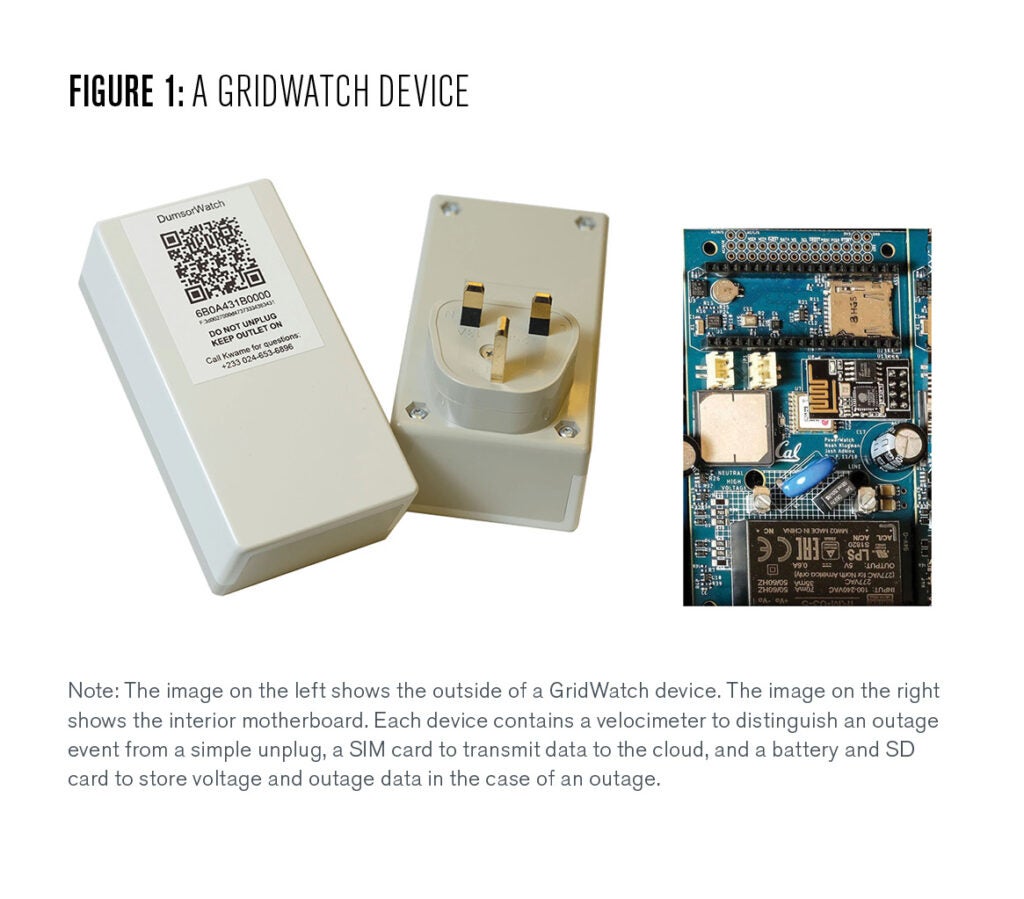
Between 2017 and 2023, the team deployed and maintained more than 1,000 GridWatch devices across Accra. Each device was deployed with a household or small business, which was compensated for each month it kept the device plugged in. To compensate for the loss of the ability to use the power socket, each study participant also received a power strip with three sockets.
Ghana’s nominal voltage is 230V (Volts). The Ghanaian Public Utilities Regulatory Commission (PURC 2005) specifies that any electric utility must ‘‘minimise voltage fluctuations on its distribution system,’’ mandating that the Electricity Company of Ghana (ECG) provide electricity with sustained voltages within 10% of nominal voltage.
But many customers routinely experience voltage well below the 230V mandated by Ghana’s electricity regulatory agency. This problem is especially pronounced during the peak demand hours of 6:00 p.m. to 10:00 p.m., where many households and businesses routinely experience voltage more than 20% below nominal voltage. This is strikingly different from the United States, where the largest fraction of recordings not within 10% of nominal voltage for any single month is only 0.1% (Pecan Street 2018).
To visualize the problem in Ghana, Figure 2 shows the actual voltage recorded by a random sample of 20 GridWatch devices deployed with households and businesses in Accra, over a week in January 2022.
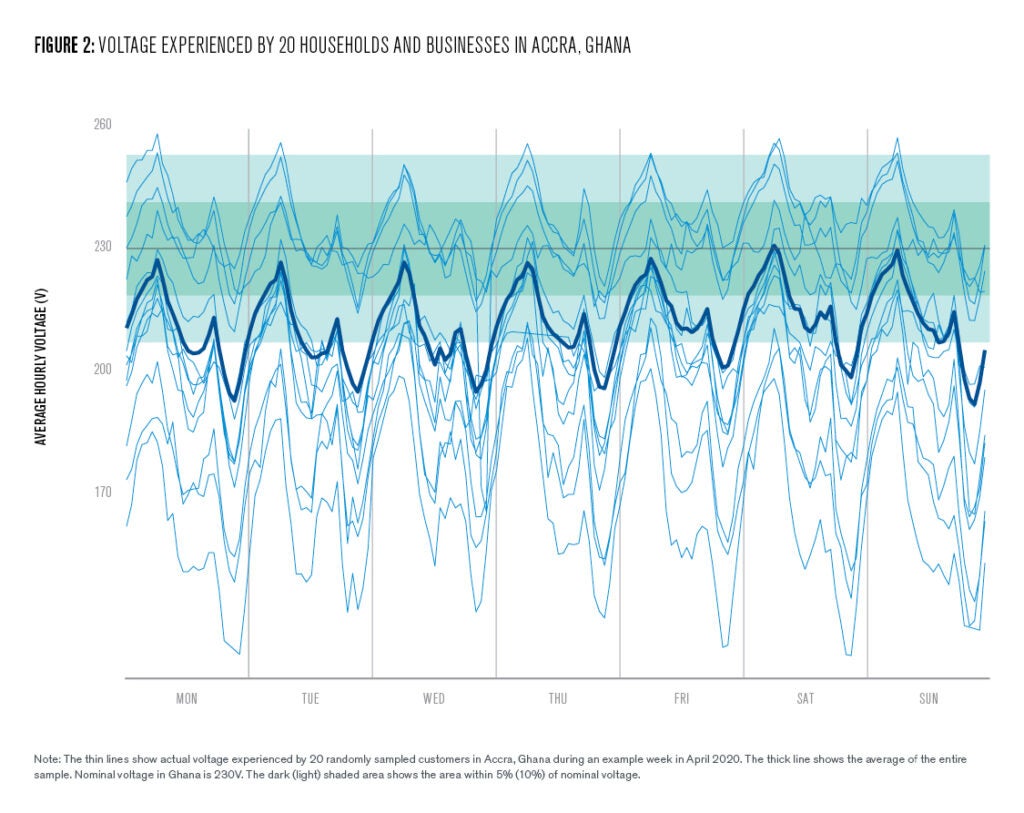
The data point to severe problems with voltage quality. Between March 2019 to November 2020, customers experienced, on average, 219V. This is outside the optimal range for most appliances in Ghana, which are typically rated for 220-240V (unlike modern appliances in high-income contexts, which are often rated for a wider range). In a given hour, voltage was 10%–20% below nominal voltage about 17% of the time (adding up to 115 hours each month) and more than 20% below nominal 5% of the time.
Customers experienced 43 events per month when the voltage fell below 200V for at least two minutes. Finally, voltage is consistently worst between 7:00 p.m. to 10:00 p.m., when load is highest. These novel measures show that voltage frequently deviates from the nominal range and that these instances can be of considerable duration.
In March–April 2021, our research team surveyed more than 2,000 businesses and households in Accra, Ghana about their electricity connections. Respondents reported experiencing, on average, 1.6 hours of bad voltage per day, and 25% reported owning a device that protects their appliances against power outages and voltage fluctuations, such as a stabilizer or a TV or fridge guard.
The average estimated value of such protective devices, for those that had them, is $51 (USD). A reported 26% of respondents had appliances damaged by voltage fluctuations in the past year—those who did spent, on average, $39 repairing or replacing these appliances, which is about 10% of both average household monthly income and average monthly business revenues. Among small businesses, 31% reported that voltage fluctuations are an obstacle to their business operations.
Respondents also reported that they are willing to pay, on average, an additional $3.40 per month to access an electricity connection with no voltage or outage issues. This constitutes an 18% increase in their monthly electricity spending.
Importantly, they were willing to pay a similar amount for connections with improved voltage as for connections with reduced outages. Additionally, when asked to allocate hypothetical government funds across five possible general economic investments, they allocated 15% of the funds to improving voltage quality, similar to the amount they allocated to reducing outages (17%). All these results, taken together, suggest that people would value voltage improvements similarly to outage reductions, which have received a great deal of attention in Ghana and elsewhere.
Constructing Additional Transformers
In 2014, the Government of Ghana and the Millennium Challenge Corporation (MCC) signed the Ghana Power Compact, a $316 million investment in Ghana’s electricity infrastructure. The goal was to strengthen the Ghanaian electricity grid infrastructure and help support rapid economic growth.
Distance to a customer’s nearest transformer is a key determinant of voltage quality: for every ten additional customers connected between a customer and a transformer, that customer experiences, on average, 5V lower voltage (Wolfram et al. 2023). One of the projects under the compact therefore aimed to improve the quality and reliability of electricity by constructing additional transformers throughout Accra.
The technical term for this project was “line bifurcation”: an additional transformer would be added (“injected”) to the grid to shorten (“bifurcate”) the distance from electricity customers to their nearest transformer along the low-voltage network.
Panel A of Figure 3 provides a schematic. Engineers expected that this activity would reduce power outages and improve voltage quality for households whose distance to the nearest transformers was substantially shortened. We focus on the construction activity in the Achimota, Dansoman, and Kaneshie districts of Accra, which took place between October 2020 and March 2021.
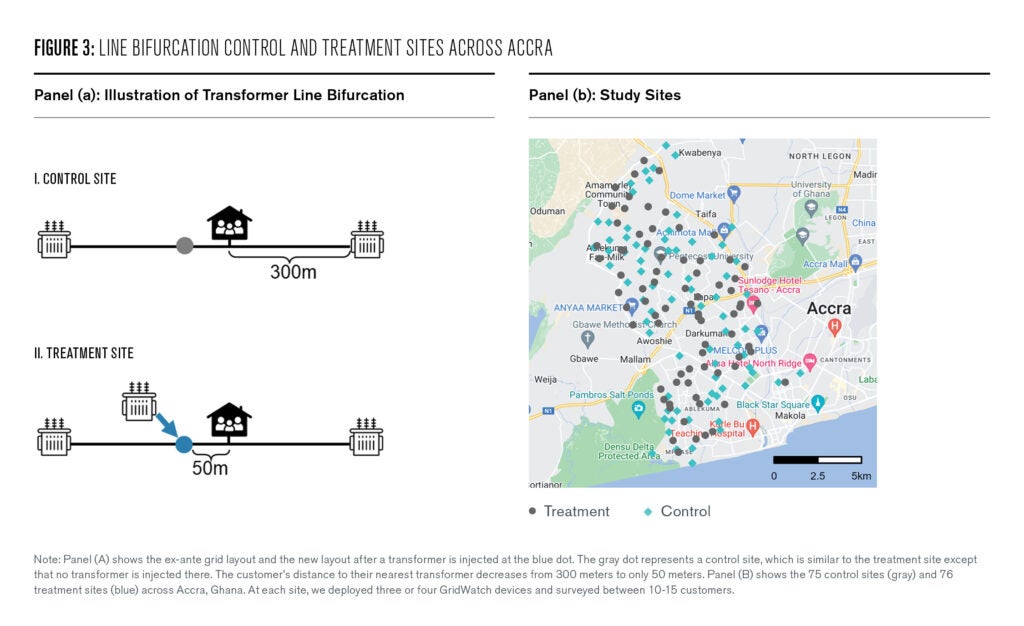
To estimate the causal impact of the transformer injections on power quality, we designed a quasi-experimental evaluation strategy. We identified the locations of all 76 treatment sites where new transformers would be injected in the three focus districts of Accra and followed the same criteria to identify 75 control sites where a transformer might have been injected but was not.
In each site, we surveyed a random sample of households and businesses within 250 meters along the electricity network from the actual or placebo transformer injection location, and deployed three to four GridWatch devices.
Figure 3, Panel (B) displays the geographic distribution of the control and treatment sites across Accra, Ghana. New transformers were constructed between October 2020 and March 2021. We focus on GridWatch data collected between March 2019 and April 2023, baseline surveys with electricity customers conducted in March-April 2021, and endline surveys conducted in July-September 2022. Levels and trends in outage hours and average voltage are nearly identical across treatment and control sites before the line bifurcation intervention, and baseline characteristics of survey respondents were similar across treatment and control sites.
Voltage Improvements
To evaluate how the construction of additional transformers affected voltage quality, we compared GridWatch data collected before October 2020 with data from after March 2021—before and after the construction took place—separately for control and treatment sites. Figure 4 displays average monthly voltage experienced by households and businesses at the control and treatment sites.
We see a clear impact of the construction activity on voltage levels. While average voltage was similar across control and treatment sites prior to the construction activity—averaging around 219V— the intervention increased average voltage by 5.5V in treatment sites relative to control sites. Notably, after construction, voltage at treatment sites averages 230V—right around Ghana’s nominal voltage. The intervention also reduced the time spent with low quality voltage in a given month—voltage more than 10% below nominal—by 37 hours. More severe low-voltage spells also decreased by over 50%.
Interestingly, control sites also experienced an increase in average voltage of 5V relative to the pre-construction period. The improvements do not appear to be due to spatial spillovers from nearby treatment sites—there is no difference across control sites by difference to the nearest treatment site. Instead, these voltage improvements could be a result of other large-scale investments that the MCC made as part of the Ghana Power Compact or due to changes in electricity consumption owing to COVID-19 or other economic forces.
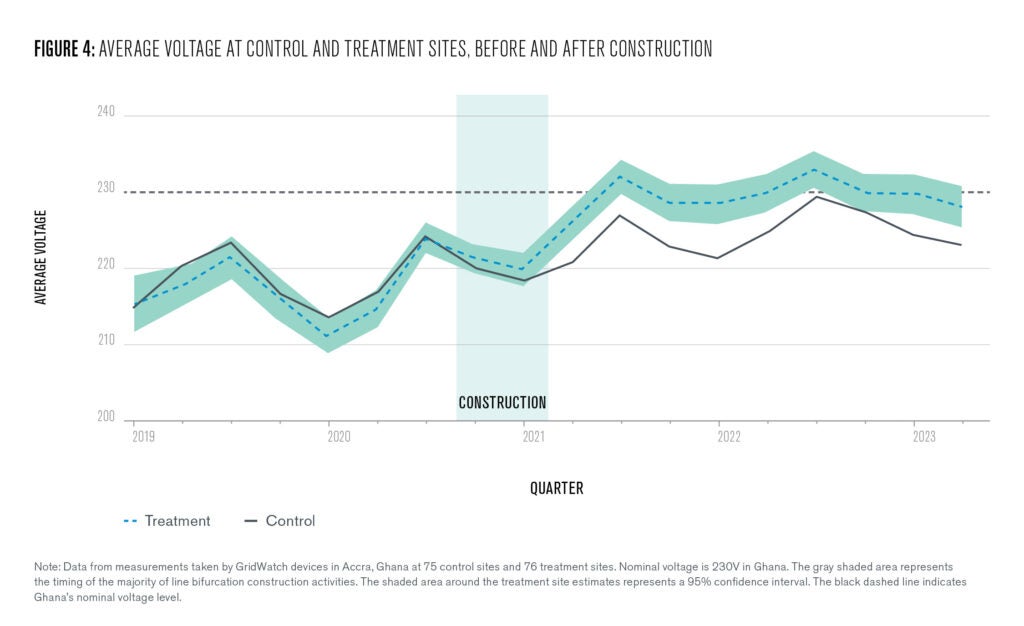
Economic Impacts
Figure 5 summarizes the economic impacts of the intervention using a difference-in-differences empirical approach with the household and business survey data. First, we see that the voltage damage and protection index (comprising two components: whether appliances were damaged by voltage in the past year and whether the respondent has any voltage protective device) reduced for the treatment sites relative to the control sites between baseline and endline.
This result aligns with the voltage improvements measured by the GridWatch devices at treatment sites. On the other hand, changes in self-reports of hours of bad voltage, spending on appliances damaged by voltage issues, and willingness to pay for improved electricity connections are not significantly different for the treatment sites compared to the control sites.
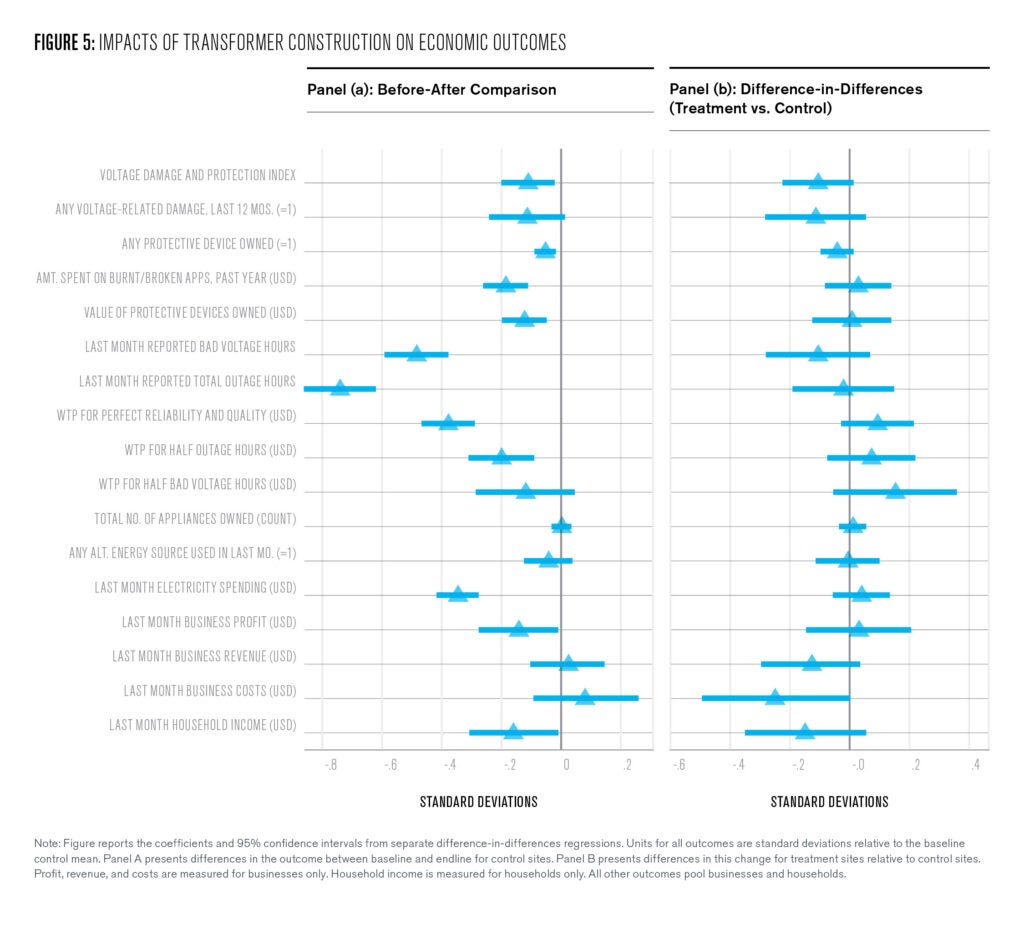
Second, improvements in voltage resulting from the construction of additional transformers did not affect other household or business outcomes, including electricity spending, ownership of appliances, household income, and business profits. We find a significant decrease in business expenditures, but this does not survive adjustment for multiple hypotheses testing, and we find no effects of the LB treatment on other measures of business activity.
Conclusion
Global energy policy in low- and middle-income countries has thus far placed limited focus on the role of voltage quality for economic activity, in part due to data limitations for measuring both the severity of voltage problems and the impact on households and businesses. We generate some of the first evidence on the large-scale economic impacts of voltage quality problems.
Poor voltage quality is a pervasive problem: average voltage is 219V—well below nominal voltage of 230V—and is more than 10% below nominal approximately 20% of the time. These issues create real economic costs for customers in terms of appliance damages and interference with business operations.
Households and businesses are willing to pay similar amounts for electricity connections with reduced outages and with improved voltage, indicating that electricity quality imposes similar costs on customers as electricity reliability
An intervention that added transformers to the grid increased average voltage by 5V—especially reducing the most severe voltage problem—and modestly reduced voltage-related damages and ownership of protective devices.
However, the investment had no impact on household and businesses outcomes, such as electricity spending, appliance ownership, business profits, and household income. The economic benefits of voltage improvements may be larger at lower voltage levels, or take longer than a year to materialize. Still, governments may prefer to invest in other publicly-provided goods or to identify more cost-effective ways to improve voltage quality.
These results present novel evidence on the economic costs of voltage quality, while at the same time highlighting the difficulty of achieving meaningful voltage improvements through infrastructure construction. We offer a framework with which to evaluate voltage quality investments. Resource-constrained governments will need to evaluate the economic benefits of voltage improvements against the high cost of these infrastructure investments.
Susanna Berkouwer
Assistant Professor of Business Economics & Public PolicySusanna Berkouwer is an assistant professor of Business Economics & Public Policy at the Wharton School.
Pierre E. Biscaye
Ph.D. Candidate, UC BerkeleyPierre Biscaye is a Ph.D. candidate at UC Berkeley studying development and environmental economics.
Maya Mikdash
Ph.D. Candidate, Texas A&M UniversityMaya Mikdash a Ph.D. candidate at Texas A&M University studying law and economics. This year she joins the Department of Economics at Louisiana State University as an assistant professor.
Steven Puller
PERC Professor in Free Enterprise, Texas A&M UniversitySteve Puller is the PERC Professor in Free Enterprise at the Department of Economics at Texas A&M University. His primary research areas are industrial organization, public economics and economic regulation, with a particular focus on energy markets.
Catherine Wolfram
William F. Pounds Professor of Energy Economics and Professor of Applied Economics, MIT Sloan School of ManagementCatherine Wolfram is the William F. Pounds Professor of Energy Economics and a Professor of Applied Economics at the MIT Sloan School of Management. She is the former Deputy Assistant Secretary for Climate and Energy Economics at the U.S. Treasury.
Berkouwer, Susanna, Pierre Biscaye, Maya Mikdash, Steve Puller, and Catherine Wolfram 2023. “Voltage Quality and Economic Activity.” Working paper.
Blimpo, M. P., & Cosgrove-Davies, M. 2019. “Electricity Access in Sub-saharan Africa: Uptake, Reliability, and Complementary Factors for Economic Impact. Washington, DC: World Bank.
Energy Sector Management Assistance Program (ESMAP) (2016). “Beyond Connections: Energy Access Redefined”. Technical Report 008/15.
https://www.esmap.org/node/56715.
Jacome, V., N. Klugman, C. Wolfram, B. Grunfeld, D. Callaway, & I. Ray. 2019. “Power Quality and Modern Energy for All. Proceedings of the National Academy of Sciences, 116 (33), 16308–16313.
Klugman, Noah, Joshua Adkins, Susanna Berkouwer, Kwame Abrokwah, Ivan Bobashev, Pat Pannuto, Matthew Podolsky et al. 2019. “Hardware, Apps, and Surveys at Scale: Insights from Measuring Grid Reliability in Accra, Ghana.” Paper presented at ACM SIGCAS Conference on Computing and Sustainable Societies (COMPASS’19), Accra, Ghana, July 3-5, 2019.
Klugman, Noah, Joshua Adkins, Emily Paszkiewicz, Molly G. Hickman, Matthew Podolsky, Jay Taneja, and Prabal Dutta. 2021. “Watching the Grid: Utility-Independent Measurements of Electricity Reliability in Accra, Ghana.” Paper presented at International Conference on Information Processing in Sensor Networks (co-located with CPS-IoT Week 2021) (IPSN’21), Nashville, TN, May 18- 21, 2021.
Meeks, R. C., A. Omuraliev, R. Isaev, & Z. Wang 2023. “Impacts of electricity quality improvements: Experimental evidence on infrastructure investments.” Journal of Environmental Economics and Management, 102838.
Public Utilities Regulatory Commission. 2005. “Electricity supply and distribution (technical and operational) rules.”
Pecan Street Inc. 2018. Dataport. https://www.pecanstreet.org/dataport/
The Sustainable Development Goals Report 2022 (tech. rep.). 2022. United Nations.
Wolfram, Catherine, Edward Miguel, Eric Hsu, and Susanna Berkouwer. 2023. “Donor Contracting Conditions and Public Procurement: Causal Evidence from Kenyan Electrification.” National Bureau of Economic Research (NBER) Working Paper #30948.





